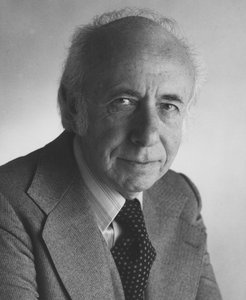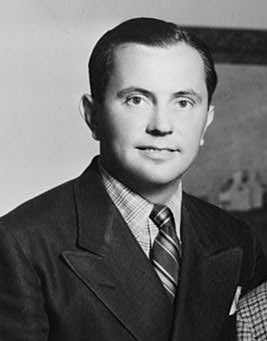
George Gershwin was an American composer and pianist whose compositions spanned popular, jazz and classical genres. Among his best-known works are the orchestral compositions Rhapsody in Blue (1924) and An American in Paris (1928), the songs "Swanee" (1919) and "Fascinating Rhythm" (1924), the jazz standards "Embraceable You" (1928) and "I Got Rhythm" (1930), and the opera Porgy and Bess (1935), which included the hit "Summertime".

Ferdinand Rudolph von Grofé, known as Ferde Grofé was an American composer, arranger, pianist, and instrumentalist. He is best known for his 1931 five-movement symphonic poem, Grand Canyon Suite, and for orchestrating George Gershwin's Rhapsody in Blue for its 1924 premiere.

New York City Ballet (NYCB) is a ballet company founded in 1948 by choreographer George Balanchine and Lincoln Kirstein. Balanchine and Jerome Robbins are considered the founding choreographers of the company. Léon Barzin was the company's first music director. City Ballet grew out of earlier troupes: the Producing Company of the School of American Ballet, 1934; the American Ballet, 1935, and Ballet Caravan, 1936, which merged into American Ballet Caravan, 1941; and directly from the Ballet Society, 1946.
Concerto in F is a composition by George Gershwin for solo piano and orchestra which is closer in form to a traditional concerto than his earlier jazz-influenced Rhapsody in Blue. It was written in 1925 on a commission from the conductor and director Walter Damrosch. A full performance lasts around half an hour.

Robert Russell Bennett was an American composer and arranger, best known for his orchestration of many well-known Broadway and Hollywood musicals by other composers such as Irving Berlin, George Gershwin, Jerome Kern, Cole Porter, and Richard Rodgers.

Morton Gould was an American composer, conductor, arranger, and pianist.

Vernon Duke was a Russian-born American composer and songwriter who also wrote under his birth name, Vladimir Dukelsky. He is best known for "Taking a Chance on Love," with lyrics by Ted Fetter and John Latouche (1940), "I Can't Get Started," with lyrics by Ira Gershwin (1936), "April in Paris," with lyrics by E. Y. ("Yip") Harburg (1932), and "What Is There To Say," for the Ziegfeld Follies of 1934, also with Harburg. He wrote the words and music for "Autumn in New York" (1934) for the revue Thumbs Up! In his book, American Popular Song, The Great Innovators 1900-1950, composer Alec Wilder praises this song, writing, “The verse may be the most ambitious I’ve ever seen." Duke also collaborated with lyricists Johnny Mercer, Ogden Nash, and Sammy Cahn.

Lawrence Cecil Adler was an American harmonica player and film composer. Known for playing major works, he played compositions by George Gershwin, Ralph Vaughan Williams, Malcolm Arnold, Darius Milhaud and Arthur Benjamin. During his later career, he collaborated with Sting, Elton John and Kate Bush.

Darci Kistler is an American ballerina. She is often said to be the last muse for choreographer George Balanchine.

Earl Wild was an American pianist known for his transcriptions of jazz and classical music.

The Gershwin Theatre is a Broadway theater at 222 West 51st Street, on the second floor of the Paramount Plaza office building, in the Midtown Manhattan neighborhood of New York City. Opened in 1972, it is operated by the Nederlander Organization and is named after brothers George and Ira Gershwin, who wrote several Broadway musicals. The Gershwin is Broadway's largest theater, with approximately 1,933 seats across two levels. Over the years, it has hosted musicals, dance companies, and concerts.
Nadine Dana Suesse was an American musician, composer and lyricist.
Eric Himy is an American-born classical pianist of French-Spanish-Moroccan descent.
Jewels is a three-act ballet created for the New York City Ballet by co-founder and founding choreographer George Balanchine. It premièred on Thursday, 13 April 1967 at the New York State Theater, with sets designed by Peter Harvey and lighting by Ronald Bates.
John Taras was an American ballet master, repetiteur, and choreographer.
Tribute is a ballet made by Christopher d'Amboise to music by Johann Sebastian Bach. The première took place Saturday, June 4, 2005, at the School of American Ballet workshop performance, Juilliard Theater, Lincoln Center for the Performing Arts. The New York City Ballet première was Sunday, February 4, 2007, at the New York State Theater, also at Lincoln Center.
Rachel Rutherford is a former soloist with New York City Ballet.

Who Cares? is a ballet choreographed by George Balanchine to songs by George Gershwin that were orchestrated by Hershy Kay. The ballet is split in two parts, the first danced by an ensemble, and the second focuses on four principal dancers. Who Cares? premiered on February 5, 1970, at the New York State Theater, danced by the New York City Ballet.
The Barber Violin Concerto is a ballet made by New York City Ballet ballet master in chief Peter Martins to Samuel Barber's Violin Concerto, Op. 14 (1939). The premiere was conducted by Robert Irving and took place on 12 May 1988 at the New York State Theater, as part of City Ballet's American Music Festival, with lighting by Jennifer Tipton and costumes by William Ivey Long. Two couples, one pair classical dancers, the other modern, perform a series of mix-and-match pas de deux. All four are dressed in white, with the classical dancers in point shoes and ballet slippers, and the modern dancers typically barefoot and the man bare-chested.
Maria Calegari is an American ballet dancer, teacher and répétiteur. She joined the New York City Ballet in 1974 and became a principal dancer in 1983. She left the company in 1994, then occasionally performed until 2004. She also teaches ballet and began working as a répétiteur for the Balanchine Trust and Robbins Rights Trust in 1996 and 2003 respectively.










